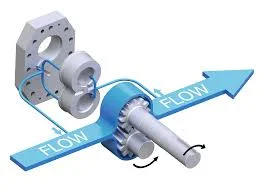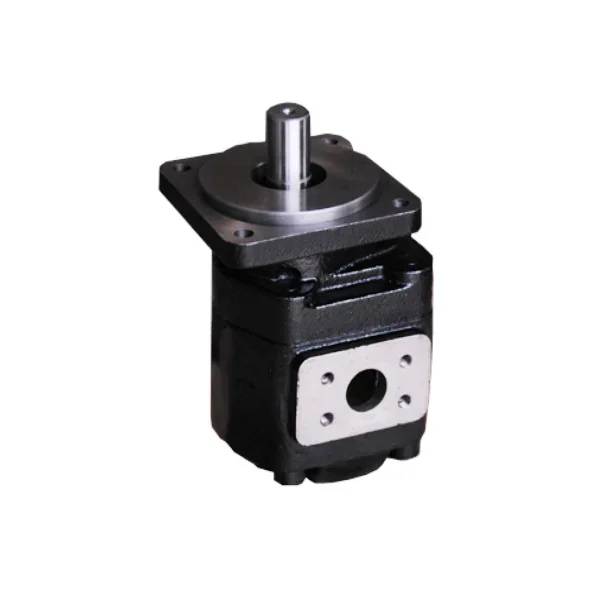In the world of fluid power, pumps play a crucial role in transferring liquids or gases from one place to another. Two commonly used types of pumps are gear pumps and piston pumps. While both serve the same purpose of fluid transfer, they operate using different mechanisms and offer distinct advantages. In this blog post, we will explore the difference between gear pumps and piston pumps, focusing on their working principles, applications, efficiency, and maintenance requirements.
I. Working Principles of Gear Pump And Piston Pump
Gear pumps and piston pumps operate on different principles, resulting in variations in their performance and characteristics.
A. Gear Pump:
A gear pump consists of two meshing gears, typically referred to as the driving gear and the driven gear. As the driving gear rotates, it meshes with the driven gear, creating a sealed chamber between the gear teeth and the pump housing. The rotation of the gears causes the fluid to be drawn into the pump and then expelled through the outlet.
B. Piston Pump:
A piston pump utilizes reciprocating pistons to transfer fluid. It consists of a cylinder block with multiple cylinders, each containing a piston and a suction and discharge valve. As the crankshaft rotates, it pushes the pistons back and forth within the cylinders. This reciprocal motion creates suction, drawing fluid into the cylinder, and then pushes it out through the discharge valve.

II. Applications of Gear Pump And Piston Pump
Gear pumps and piston pumps find applications in various industries and systems based on their specific characteristics and capabilities.
A. Gear Pump:
Gear pumps are commonly used in applications where a continuous flow of fluid is required at a consistent pressure. They are suitable for handling viscous fluids, such as oils, fuels, and hydraulic fluids. Gear pumps are often used in hydraulic systems, lubrication systems, and transfer pumps.
B. Piston Pump:
Piston pumps are known for their ability to generate high pressures, making them suitable for applications requiring high pressure and variable flow rates. They are commonly used in hydraulic systems, where precise control of pressure and flow is necessary. Piston pumps are often found in construction machinery, industrial equipment, and heavy-duty hydraulic systems.
III. Efficiency of Gear Pump And Piston Pump
Efficiency is an important aspect to consider when comparing gear pumps and piston pumps.
A. Gear Pump:
Gear pumps are generally less efficient compared to piston pumps. The meshing gears create leakage paths, leading to internal slip and reduced volumetric efficiency. The efficiency of gear pumps can be further affected by factors such as fluid viscosity and pressure. However, gear pumps offer good mechanical efficiency, as they have fewer moving parts and lower friction losses.
B. Piston Pump:
Piston pumps are known for their high efficiency, especially at higher pressures. The reciprocating motion of the pistons allows for tight sealing, minimizing internal leakage. This results in higher volumetric efficiency compared to gear pumps. However, piston pumps have more moving parts, which can contribute to higher mechanical losses and maintenance requirements.

IV. Maintenance Requirements About Gear Pump And Piston Pump
Maintenance requirements differ between gear pumps and piston pumps, influencing the overall cost of ownership and system uptime.
A. Gear Pump:
Gear pumps generally have lower maintenance requirements due to their simpler design and fewer moving parts. The gear teeth are the primary components that may require occasional inspection and replacement. Regular checks for wear, proper lubrication, and monitoring of fluid cleanliness are necessary for optimal gear pump performance.
B. Piston Pump:
Piston pumps, with their more complex design and additional components, require regular maintenance to ensure reliable operation. The pistons, piston rings, valves, and cylinder block may need periodic inspection and replacement. Proper lubrication, alignment, and monitoring of fluid contamination are crucial for maintaining piston pump performance and longevity.
V. Other Factors to Consider
While the working principles, applications, efficiency, and maintenance requirements are important factors to consider when choosing between gear pumps and piston pumps, there are a few additional aspects worth noting:
Noise: Gear pumps tend to generate more noise compared to piston pumps due to the meshing gears. Piston pumps, with their smoother operation, produce less noise.
Pressure and Flow Control: Piston pumps offer better pressure and flow control capabilities compared to gear pumps. Variable displacement piston pumps can adjust flow rates according to system demands, providing greater flexibility.
Size and Weight: Gear pumps are generally more compact and lightweight compared to piston pumps, making them suitable for applications with space constraints.

Conclusion
In summary, while both gear pumps and piston pumps serve the purpose of fluid transfer, they differ in their working principles, applications , efficiency, and maintenance requirements. Gear pumps are known for their simplicity, reliability, and suitability for continuous flow applications. On the other hand, piston pumps excel in high-pressure and variable flow applications, offering greater efficiency and precise control. Understanding these differences is essential for selecting the right pump for specific system requirements, ensuring optimal performance and longevity.
At Shanghai AJA Technology Co., Ltd., we are committed to providing high-quality products and excellent customer service. Whether you need assistance with hydraulic motor cleaning or any other hydraulic component-related queries, our knowledgeable staff is ready to help.
If you have customization needs for gear pumps, you are welcome to contact us
Email:[email protected]
